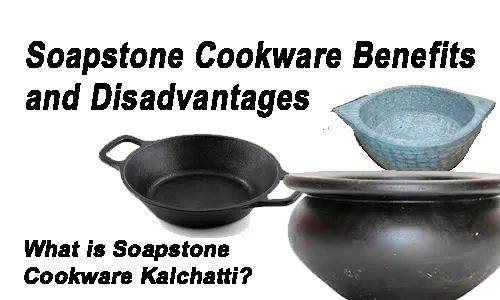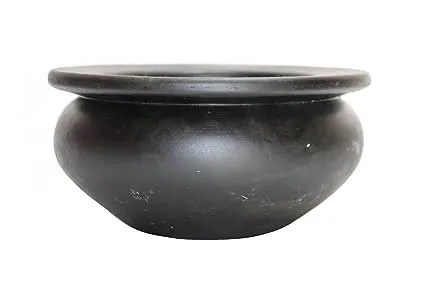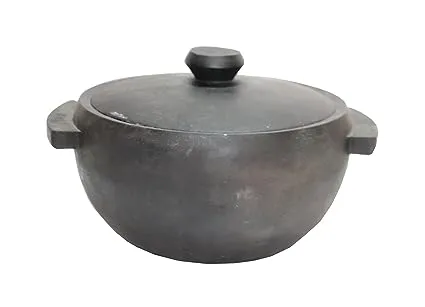Welcome to our comprehensive guide on the Soapstone Cookware Benefits and Disadvantages, and, What is Soapstone Cookware Kalchatti.
Soapstone Cookware Benefits and Disadvantages | What is Soapstone Cookware Kalchatti

What is soapstone?
Soapstone, also known as steatite, is a metamorphic rock that is largely composed of talc, a mineral known for its softness and smooth texture. It is called “soapstone” because of its soap-like feel and appearance. Soapstone is usually gray, bluish, green, or brown in color, and it can have various levels of veining and patterns.
One of the unique characteristics of soapstone is its relatively low hardness, which makes it easy to carve and shape. Historically, soapstone has been used for a variety of purposes due to its workability and heat-resistant properties. It has been used in sculptures, carvings, and ornaments, as well as for practical items like countertops, sinks, stoves, and fireplaces.
Soapstone is valued for its ability to retain and radiate heat, which makes it a popular choice for constructing stoves, fireplaces, and even cookware. The stone’s heat resistance and natural beauty have contributed to its use in both functional and artistic applications.
Because of its composition, soapstone can be relatively soft and susceptible to scratches, but it also develops a patina over time that can enhance its appearance. Some people appreciate the way soapstone darkens and develops a rich sheen as it comes into contact with oils and uses, which adds to its aesthetic appeal.
In summary, soapstone is a versatile metamorphic rock primarily composed of talc, prized for its softness, heat retention, and workability. It has been used for centuries in both functional and artistic contexts, making it a unique and interesting material.
What is Soapstone Cookware Kalchatti?
Soapstone cookware, also known as “kalchatti” or “kuruni” in South India, is traditional cookware made from soapstone, a natural metamorphic rock that has been used for centuries in cooking and food preparation.
It’s a popular choice in Indian kitchens due to its unique properties that make it suitable for slow cooking and imparting a distinct flavor to the food.
Also Read:
- What is the full form of RO UV and UF?
- Top 6 Best Smoothie Blenders in India 2023 – Tested & Reviewed
- Top 15 Best Refrigerators in India 2023 | Best Refrigerators Under 25000
- Top 10 Best Microwave Ovens in India 2023 – Reviews and Buying Guide
Soapstone cookware is typically made by carving a single piece of soapstone into the desired shape of a pot or vessel. It’s known for its heat retention and even heat distribution properties. Here are some key features and benefits of soapstone cookware:
Heat Retention:
Soapstone has excellent heat retention properties. Once heated, it can retain heat for a long time, allowing for slow and steady cooking. This is particularly useful for dishes that require long cooking times, such as stews, curries, and simmering sauces.
Even Heat Distribution:
Soapstone distributes heat evenly across its surface, preventing hot spots that can lead to uneven cooking or burning of food. This helps in achieving uniform cooking results. “Soapstone Cookware Benefits and Disadvantages, What is Soapstone Cookware Kalchatti”
Natural Flavors:
One of the unique characteristics of soapstone cookware is its ability to infuse a subtle and earthy flavor into the food being cooked. This flavor enhancement is highly valued in traditional Indian cuisine.
Durability:
Soapstone is a durable material that can withstand high temperatures without cracking or breaking. With proper care, soapstone cookware can last for generations.
Health Benefits:
Soapstone is considered a natural and non-toxic material for cooking. Unlike some modern non-stick coatings that can release harmful chemicals at high temperatures, soapstone is a safe and inert material.
Versatility:
Soapstone cookware can be used for a variety of cooking methods, including slow simmering, sautéing, frying, and even baking.
Aesthetic Appeal:
Soapstone cookware often has an attractive rustic appearance that adds to the charm of traditional cooking.
However, there are also some considerations when using soapstone cookware:
Seasoning:
Like cast iron, soapstone cookware requires seasoning to develop a natural non-stick surface and enhance its durability. Seasoning involves coating the cookware with oil and heating it gradually to create a patina. “Soapstone Cookware Benefits and Disadvantages, What is Soapstone Cookware Kalchatti”
Care:
Soapstone cookware should be handled carefully to prevent chipping or cracking. Rapid temperature changes, such as placing a hot pot in cold water, should be avoided.
Weight:
Soapstone cookware can be heavy, which might make it less suitable for individuals who prefer lightweight options. “Soapstone Cookware Benefits and Disadvantages, What is Soapstone Cookware Kalchatti”
Maintenance:
Soapstone cookware should be cleaned with mild detergents and soft brushes. Harsh scrubbing or abrasive cleaning materials can damage the seasoning and surface of the cookware.
Overall, soapstone cookware is a traditional and unique option for cooking that has been used for generations in certain cultures, especially in India. Its ability to provide slow, even, and flavorful cooking makes it a valuable addition to the kitchen.
Soapstone Cookware Benefits and Disadvantages

Soapstone Cookware Benefits
Certainly, here are the benefits of soapstone cookware:
Excellent Heat Retention:
Soapstone retains heat effectively, allowing for steady and prolonged cooking, ideal for dishes requiring slow simmering.
Even Heat Distribution:
With consistent heat distribution, soapstone prevents uneven cooking and burning, ensuring uniformly cooked meals.
Natural Flavor Infusion:
Soapstone imparts a subtle, earthy flavor to food, enhancing the taste, particularly appreciated in traditional cuisines.
Durability:
Soapstone can endure high temperatures without cracking, offering long-lasting cookware that can be passed down through generations.
Health Safety:
Being a natural and inert material, soapstone is a healthy cooking option, free from the potential risks associated with some non-stick coatings.
Versatility:
Soapstone cookware is versatile, and suitable for various cooking techniques including simmering, sautéing, frying, and baking. “Soapstone Cookware Benefits and Disadvantages, What is Soapstone Cookware Kalchatti”
Aesthetically Pleasing:
The rustic appearance of soapstone cookware adds to its visual appeal, enhancing the traditional cooking experience.
Remember that proper seasoning and care are essential for maintaining soapstone cookware’s performance and longevity.
Soapstone Cookware Disadvantages
Certainly, here are the disadvantages of soapstone cookware:
Weight:
Soapstone cookware can be heavy, which might pose difficulties for those who prefer lighter options or have limited strength. “Soapstone Cookware Benefits and Disadvantages, What is Soapstone Cookware Kalchatti”
Fragility:
While soapstone is durable, it is still susceptible to chipping or cracking if dropped or subjected to rapid temperature changes.
Seasoning Required:
Similar to cast iron, soapstone cookware requires regular seasoning to develop a non-stick surface and maintain its performance.
Maintenance:
Soapstone cookware needs careful cleaning with mild detergents and soft tools to avoid damaging the seasoning or surface.
Initial Cost:
Soapstone cookware can be more expensive compared to other types of cookware due to the material’s sourcing and craftsmanship.
Limited Availability:
Finding soapstone cookware might be challenging, as it’s less common than more widely available materials like stainless steel or non-stick coatings.
Flavor Absorption:
While the natural flavor infusion is a benefit, soapstone’s porous nature can also lead to flavors being absorbed, which might not be desirable for some dishes.
Understanding these disadvantages can help individuals make an informed decision when considering whether soapstone cookware is suitable for their cooking needs and preferences.
Type of Soapstone Cookware
Certainly, here are some common types of soapstone cookware:
Soapstone Pots:
Soapstone pots are versatile vessels used for slow cooking, simmering, and stewing. They come in various sizes and shapes to accommodate different dishes.
Soapstone Pans:
Soapstone pans are suitable for sautéing, frying, and shallow cooking. They often have flat bottoms and slightly raised sides for easy tossing and stirring.
Soapstone Griddles:
Soapstone griddles are large, flat cooking surfaces used for making items like pancakes, dosas, and flatbreads. They provide even heating and natural non-stick properties.
Soapstone Tawas:
Tawas are small, round soapstone griddles used primarily for making Indian breads like rotis and parathas. They’re designed to fit over a stove burner.
Soapstone Mortar and Pestle:
Soapstone mortar and pestle sets are used for grinding and mixing spices, herbs, and pastes in traditional cooking.
Soapstone Tea Kettles:
These kettles are used for boiling water to make tea and other hot beverages. The heat retention of soapstone helps keep liquids warm.
Soapstone Bowls:
Soapstone bowls are used for serving hot dishes, as soapstone retains heat well. They can also be used for slow-cooking stews and soups.
Soapstone Utensils:
Soapstone spatulas, ladles, and spoons are crafted for cooking in soapstone cookware, maintaining the traditional theme.
Soapstone Roasting Pans:
Larger soapstone pans with higher sides are used for roasting meats and vegetables in the oven.
Soapstone Cooking Slabs:
These slabs can be used as natural hot plates or for baking bread and pizza in ovens.
Each type of soapstone cookware has its own specific uses and advantages, contributing to the diverse range of cooking possibilities it offers.
Top 5 Soapstone Cookware Kalchatti
1. CAROTE 20CM/1.1L Non Stick Frying Pan

About this Item
- Brand – CAROTE
- Material – Granite
- Special Feature – Non Stick, Gas Stovetop Compatible, Electric Stovetop Compatible
- Colour – Steel
- Capacity – 1 Quarts
- Compatible Devices – Smooth Surface Induction, Gas
- Product Care Instructions – Hand Wash Only
2. Balaji Traders Handmade Natural Soapstone Kalchatti Cookware

Balaji Traders Handmade Natural Soapstone Kalchatti Cookware – Gas & Electric Coil Stove Compatible – Soapstone Stock Pot – 3480ml
- Material – Stone
- Finish Type – Hammered
- Brand – Generic
- Colour – Black
- Capacity – 3480 Milliliters
- Is Oven Safe – Yes
3. Balaji Traders Handmade Natural Soapstone Kalchatti Cookware with Lid

Balaji Traders Handmade Natural Soapstone Kalchatti Cookware with Lid – Gas & Electric Coil Stove Compatible – Soapstone Stock Pot – 2300ml
- Material – Stone
- Finish Type – Hammered
- Brand – Generic
- Colour – Black
- Capacity – 2300ml
- Is Oven Safe – Yes
4. Native Apertures | Soapstone Kalchatti / Maakal chatti

Native Apertures | Soapstone Kalchatti / Maakal chatti / Soapstone stock pot (Unconditioned) – Traditional – HandMade – ROHS1 Certified (Medium, Capacity: 1900 – 2100 ML, wt: 2.6 – 3.5 KG, Ht: 10 – 14 CM, Dia: 16 – 18 CM)
- Material – Stone
- Brand – Generic
- Colour – Grey
- Capacity – 1900ml
- Is Oven Safe – No
5. Bhagya Cast Iron Cookware Pre-Seasoned Mini Skillet/Fry Pan

- 8 inches Looped
- Brand – Bhagya Cast Iron Cookware
- Material – Packing
- Special Feature – Induction Stovetop Compatible, Gas Stove
- Colour – Lengthy handle
- Capacity – 1 Kilogram
- Compatible Devices – Smooth Surface Induction, Gas
- Product Care Instructions – Hand Wash Only
- Handle Material – Cast Iron
- Item Weight – 1600 Grams
Conclusion: Soapstone Cookware Benefits and Disadvantages
In conclusion, soapstone cookware, known as “kalchatti” or “kuruni” in South India, offers a unique and traditional approach to cooking that comes with distinct benefits and some limitations. The advantages of soapstone cookware are numerous:
its exceptional heat retention and even heat distribution make it perfect for slow and steady cooking. The natural flavor infusion it provides enhances the taste of dishes, particularly in traditional cuisines. Additionally, soapstone’s durability, health safety, and versatility contribute to its appeal in the kitchen.
However, there are certain disadvantages to consider. The weight of soapstone cookware might be a concern for those who prefer lighter options. Careful handling is essential to avoid fragility issues, as soapstone can chip or crack.
Regular seasoning and specific maintenance are required to maintain its performance and longevity. The initial cost of soapstone cookware can be higher than other alternatives, and its availability might be limited in comparison.
“Kalchatti” or “kuruni,” as soapstone cookware is known in South India, encompasses various types including pots, pans, griddles, and more. These utensils have been cherished for generations for their ability to retain heat, impart flavor, and contribute to the rich cultural heritage of traditional cooking.
In summary, soapstone cookware offers a unique culinary experience with its ability to create flavorful, evenly cooked dishes. While it comes with considerations, its benefits and cultural significance make it a valuable addition to kitchens for those who appreciate the art of slow, flavorful cooking.
FAQs about Soapstone Cookware Benefits and Disadvantages
Soapstone cookware, often referred to as “kalchatti” in South India, is traditional cooking equipment made from soapstone, a natural rock. It’s known for its unique properties that enhance slow cooking and flavor infusion in dishes.
Soapstone cookware offers excellent heat retention, even heat distribution, and imparts a natural flavor to food. It’s durable, safe for health, versatile for various cooking techniques, and has an appealing rustic appearance.
Soapstone’s density allows it to absorb and retain heat for extended periods, making it ideal for slow cooking and keeping dishes warm.
Yes, similar to cast iron, soapstone cookware benefits from seasoning to develop a non-stick surface and improve its longevity.
Soapstone cookware can be heavy, potentially fragile, and requires careful handling to prevent chipping or cracking. Regular seasoning and specific cleaning methods are necessary. It can also be more expensive and less readily available compared to other cookware types.
Yes, soapstone is a natural and inert material, making it a safe choice for cooking without the concerns associated with some non-stick coatings.
Absolutely, soapstone cookware is versatile and suitable for slow cooking, sautéing, frying, baking, and more.
Yes, soapstone imparts a subtle, earthy flavor to food, which is particularly valued in certain traditional cuisines.
Soapstone cookware should be cleaned with mild detergents and soft tools. Avoid harsh scrubbing, rapid temperature changes, and dropping to ensure its longevity.
Soapstone cookware is great for slow-cooked dishes, stews, curries, flatbreads, and any recipe that benefits from steady, even heating.
Yes, soapstone cookware is suitable for oven use, making it versatile for a wide range of cooking methods.
Soapstone cookware might be available in specialty stores or online retailers that focus on traditional and artisanal kitchenware.
Yes, while soapstone cookware has traditional roots, it can add a unique touch to modern kitchens that appreciate the benefits of slow, flavorful cooking.
Certainly, soapstone cookware can be a meaningful and distinctive gift for individuals who enjoy cooking and exploring traditional culinary techniques.
Handle soapstone cookware carefully to prevent chipping or cracking. Allow it to cool before cleaning, and avoid drastic temperature changes.
Soapstone cookware is not typically compatible with induction stoves unless it has a magnetic base.
Soapstone is generally resistant to acidic ingredients, but prolonged exposure might affect the seasoning or appearance of the cookware.
Yes, soapstone is a natural and sustainable material, aligning with environmentally conscious choices in the kitchen.
Yes, with proper care and maintenance, soapstone cookware can last for many years, making it suitable for passing down to future generations.
Soapstone cookware holds cultural significance in various cuisines, particularly in South India, where it has been a traditional tool for slow cooking and flavor enhancement for centuries.
Soapstone is a metamorphic rock primarily composed of talc, with varying levels of chlorite, pyroxenes, micas, amphiboles, carbonates, and other minerals. Its name comes from its smooth, soapy texture.
Soapstone’s unique properties make it popular for carving sculptures, making countertops, sinks, and architectural elements. Its ability to absorb, retain, and radiate heat also makes it suitable for stoves, fireplaces, and cookware.
Soapstone is heat-resistant, chemically inert, and has a natural resistance to staining. It develops a distinct patina over time, which adds character. Its versatility and aesthetic appeal make it a desirable choice for both functional and decorative applications.
Yes, soapstone countertops are a popular choice due to their durability, heat resistance, and natural beauty. However, potential buyers should be aware that soapstone is softer than other countertop materials and can develop a patina over time.
Thanks for visiting TrustWelly.com
